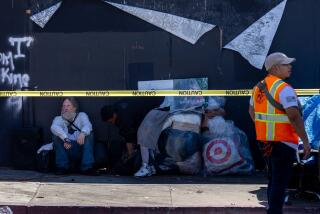Bradley Asks City Council to Finance Prefab Units for Homeless
- Share via
Mayor Tom Bradley urged the City Council on Friday to approve a $6.3-million plan to buy enough prefabricated housing units to shelter up to 2,000 homeless people.
The mayor also challenged each of the 15 council members--including some skeptics--to find sites for the homes within their districts. This would be a departure from the pattern of placing low-income housing in economically depressed neighborhoods.
“Our homeless are scattered all over this city. The solutions should be all over this city,” Bradley said in a press conference after his appeal to the council.
The mayor told the council the proposal--the most far-reaching plan he has proposed to deal with the homeless--is “an unusual, unmatchable bargain.” He described the units themselves as “magnificent living quarters.”
Bringing in the prefabricated housing, the mayor said, “is not a total answer, but a significant step forward.”
Under Bradley’s plan, the city would enter a lease-purchase agreement with the Utah-based Intermountain Power Agency to acquire buildings that had been used to house workers during a massive power plant construction project. The power company is a major energy supplier to the Los Angeles Department of Water & Power.
The homes, Bradley told the council, “can be transported from Utah and be readied for rent as soon as the City Council gives the purchase a green light and approves housing sites throughout the city.”
Bradley estimated that the council would need about a month to identify potential locations. Officials say that land owned by the city Housing Authority and by nonprofit social service agencies are the likely destinations for the new housing.
The purchase would include 390 single-room units with shared bath facilities and 240 one-, two- and three-bedroom modular apartments. The cost of buying and moving the single-room units would run about $2.2 million, or about $5,600 per room. The apartments--envisioned as family housing--would cost $4.1 million, or about $18,000 per apartment.
“These low-income housing units are sound, solid and come complete with heating and air conditioning. Compared to the cost of building comparable housing, the city’s cost is an unqualified bargain,” he said.
Mayoral aide Art Gastelum, who joined Bradley in negotiations with IPA, said the city would receive the units at “salvage cost” totaling about 70% less than the IPA’s original expense. The city outbid private developers who also were interested in the units, he said.
Bradley said the money could be raised from a variety of sources, including federal housing funds.
If approved by the council, the purchase would be Los Angeles’ second major housing transaction with IPA. In July, the power company sold the city 102 two- and three-bedroom mobile homes for $1.4 million. City officials are still trying to determine where they will place the trailers, which they say will be used as “transitional” housing for homeless families.
Officials acknowledge that many sites for the housing would trigger neighborhood disputes. Such controversy would likely be magnified in the placement of the single-room units that would primarily house low-income and unemployed men.
Expresses Confidence
“There are people who don’t want them in their neighborhoods,” Bradley acknowledged. The mayor said he is “confident,” however, that neighborhoods could be found “where such building can be located and such people can be housed.”
Another hurdle would be management of the housing. Bradley said he would appoint a committee made up of representatives from various housing-related agencies to develop a management plan and rent structure.
Bradley made his pitch as the city’s controversial “urban campground”--dubbed Camp Tom Bradley by some critics--is winding down to a Sept. 18 closure, having already provided shelter for 2,200 people since its June opening. The camp, which was filled to a 600-person capacity for several weeks, now has about 330 residents, according to the Salvation Army.
Most council members were guarded in their reaction to the mayor’s proposal. But Councilman Gilbert Lindsay, whose district includes downtown’s Skid Row and many homeless shelters, said he would welcome the units as improvements over the vacant lots that dot much of his territory.
Holden Is Dubious
Councilman Nate Holden was dubious, noting that even newly constructed housing projects generate outcries from nearby residents.
Councilwoman Joan Milke Flores, whose district includes half of the city’s public housing units and several shelters for the homeless, said she would not agree to accept any of the prefabricated houses until the city completes a citywide inventory of facilities for the homeless and other low-income residents.
Flores’ district, which includes Watts and the harbor area, was originally slated to receive about 70 of the recently purchased 102 mobile home units. Flores balked at that plan, saying the city was unloading its homeless problem on her district. She said Friday that she has now agreed to accept 24 of the mobile homes, half of which will be placed at the Normont Terrace housing project in Harbor City.
Points to Affluent Areas
“I don’t mind doing my share,” Flores said, “but I don’t want to do mine and everybody else’s, too.” Affluent areas, she said, should be targeted for public-supported housing as well as poorer areas.
Councilman Zev Yaroslavsky, who represents portions of the Westside and the San Fernando Valley, said through an aide that he believes that it is the mayor’s responsibility to find locations for such housing.
“We have very little available space,” said Michelle Krotinger, Yaroslavsky’s press aide. “Everything in our whole district is so built up.”
Times staff writer Penelope McMillan contributed to this story.
More to Read
Sign up for Essential California
The most important California stories and recommendations in your inbox every morning.
You may occasionally receive promotional content from the Los Angeles Times.






